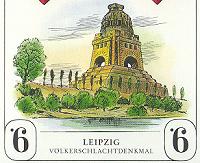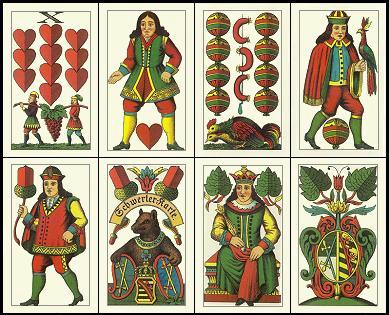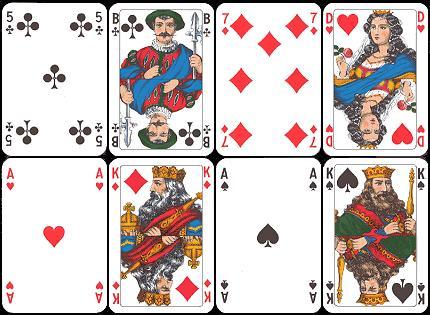In this list the official names are mentioned, but some of the patterns have alternative ones too.
With the exception of the
Württenbergisches Bild, the latest one created (c.1870), all the German-suited patterns were born single-headed; but since players found themselves more comfortable with double-headed designs, all of them gradually turned to the latter scheme, starting with the
Preussisches Bild and
Fränkisches Bild (second half of the 19th century) and ending with the
Bayerisches Bild, which steadily became double-headed around 1950, or shortly later.

Preussisches Bild by ASS (Germany), a northern pattern |
The Preussisches Bild is the only pattern among the ones now extant that partly remained single-headed: its pip cards alone maintained the old design. The space at the bottom was originally filled with with naive genre scenes; then, as of the end of WW I, they were replaced by town views. The knaves, instead, reflect Germany's 19th century social structure, with rich bourgeois playing the part of ober knaves, and members of the middle-low class (a waiter, an inn-keeper, etc.) representing the unter rank.
Both the Preussisches Bild and the Sächsisches Bild are still in production, but they were largely replaced by the Neues Altenburg Bild when the latter was introduced, in the 1960s (see page 2 for details). |



Preussisches Bild: details of a few town views from F.X.Schmid's edition; the first one on the left
features Danzig, now in Poland, but German by the time the Prussian pattern was created
All the southern designs sprang from an early single-headed pattern called
Altbayerisches ("old Bavarian"), by gradually acquiring subjects and details from other German and non-German designs, such as the German
Tarock, and the French and Dutch national patterns.
Because of this, the list of German-suited patterns may also include the
Prager Bild ("Prague pattern"), presently used only in the Czech Republic, as this Bohemian design too sprang from the
Altbayerisches cards; in the past, editions of this pattern were also made by some German manufacturers, either for the Czech market or for the benefit of Czech immigrants.
In recent times, a revival of single-headed designs has brought back this version of the Bayerisches Bild (see page 2) and of the Sächsisches Bild.
The latter is also referred to as Schwerterkarte, i.e. "sword cards", after the shield with crossed swords, from the coat of arms of the archduchy of Meissen, found in the daus of Acorns and of Leaves. The former subject also features the name Schwerterkarte on a ribbon above the bear, sometimes maintained also in double-headed editions, despite in these ones the shield with crossed swords is no longer visible.
However, also for the Sächsisches Bild, as well as for the Bayerisches Bild, the more common variety is now still the one with double heads. |

single-headed Sächsisches, or
Schwerterkarte (by S.A.);
note the shield with crossed swords in the two daus cards |
The
Ansbacher Bild, also known as
Nürnberger Bild, after the town of Nuremberg where it was originally produced, turned obsolete around the mid 20th century. It always maintained its original single-headed design, not very different from the aforesaid
Prager Bild (see
page 3); actually, Nuremberg is not too far from the Czech border.

the extinct Ansbacher (Nürnberger) Bild, by F.X.Schmid |
This pattern is characterized by very naive illustrations, which faithfully reproduce the woodblock prints of the earliest editions. Curiously, in the suits of Hearts and Bells the daus cards are extremely simple (one of them appears in the picture on the left): their two pips are not accompanied by the usual decorations , whereas the 6 of Hearts is certainly more ornate than in other patterns.
Probably the Ansbacher Bild did not spring from the Altbayerisches Bild, as all other southern patterns, but developed directly from the first samples of German-suited cards (16th-17th centuries), thus claiming an earlier lineage than any other extant design. But instead of becoming double-headed, as the others did, it sadly disappeared. |
Also two French-suited patterns come from Germany, although only one of them is still used. They sprang from different parts of the country: the
Rheinisches Bild ("Rhineland pattern") is from the south-west, while the
Berliner Bild (Berlin pattern) is from the north.
The Berlin pattern, also called Französisches Bild i.e. "French pattern", is slightly earlier than the other one, having been created during the first half of the 19th century, according to the graphic guidelines of the transitional style known as Biedermeier (c.1815-1840) that acted as a bridge between Neoclassicism and Romanticism. A few details, though, such as the harp held in hand by king of Spades, reveal that the French national pattern too undoubtly exerted its own influence on this design, in some degree. |

Berliner Bild by F.X.Schmid (Germany) |
Despite its name, the Berlin pattern originated in Stralsund, in the northernmost corner of Germany, first printed by the famous manufacturer Spielkartenfabrik Altenburg.
When in the early 1900s the latter took over another famous maker, Büttner of Berlin, the words
Berliner Spielkarten ("Berlin cards") began to appear on the courts of the pattern, whence the name
Berliner Bild it was labelled with ever since.

detail of the king of Spades in different editions (from the left: ASS, Berliner Spielkarten, F.X.Schmid);
note that the harp in the third edition has no strings

Berliner Bild (by ASS) |
Today the Berliner Bild is produced by almost every German manufacturer; it is the main pattern used for playing Skat in a wide area, that includes the whole north and west of the country. In the modern editions by ASS, the sign of Diamonds is outlined (picture on the left).
The Berlin pattern also exists in a particular variety with suits in four different colours, called the Turnierbild ("tournament pattern"); despite being a regular pattern, it is featured in gallery 3, page 3, among the colour variants. |
 |
The edition shown on the left was made by the Spielkartenfabrik Altenburg around 1970, when the company was in East German territory. The colours of the courts slightly differ from those of most other Berlin editions, and their faces are vaguely reminiscent of the ones found in the New Altenburg pattern (described in page 3), which only a few years earlier had been created by the same manufacturer.
An even closer connection between the Berlin and New Altenburg designs is represented by the two-way Kongress pattern, described in page 3, as well. |
Also the Rheinisches Bild was created by a famous manufacturer, Dondorf of Frankfurt. It was first printed around 1870, as a luxury pattern; this explains the richness of colours and the refined details of the courts.
Such an attractive look gave reason for its great success: the Rhineland pattern soon spread to several neighbour countries, among which Denmark, the Netherlands, Poland, where most editions maintained the German indices "B", "D" and "K", while the original number of cards was often increased to 52, with jokers too added to the deck. |

Rheinisches Bild (Dondorf's design reprinted by ASS) |
In Germany, instead, the Rheinisches Bild subsided during the first half of the 20th century, so that the Berliner Bild remained the only French-suited pattern used in the country (not considering the Tarock, which is a tarot, and the international Bridge deck). |
GLOSSARY
 |
actual translation |
 |
| SPIELKARTEN | | PLAYING CARDS |
|---|
| SPIEL | game | DECK |
|---|
| FARBE | colours | SUITS |
|---|
| EICHEL | | ACORNS |
|---|
| LAUB (GRÜN) (SCHIPPE) | (green) (spades) | LEAVES |
|---|
| SCHELLEN | | BELLS |
|---|
| HERZ (ROT) | (red) | HEARTS |
|---|
| KARO | square | DIAMONDS |
|---|
| KREUZ | cross | CLUBS |
|---|
| PIK | pike | SPADES |
|---|
| DAUS | deuce | ACE (German-suited decks) |
|---|
| AS | | ACE (French-suited decks) |
|---|
| UNTER | below | LOW RANK KNAVE |
|---|
| OBER | over | HIGH RANK KNAVE |
|---|
| BUBE | | JACK |
|---|
| DAME | lady | QUEEN |
|---|
| KÖNIG | | KING |
|---|
OTHER GALLERIES






















or back to

HISTORICAL
NOTES
|

MULTI-LANGUAGE
GLOSSARY |

THE FOOL &
THE JOKER |

INDEX
TABLE |

REGIONAL
GAMES |

PLAYING CARD
LINKS |